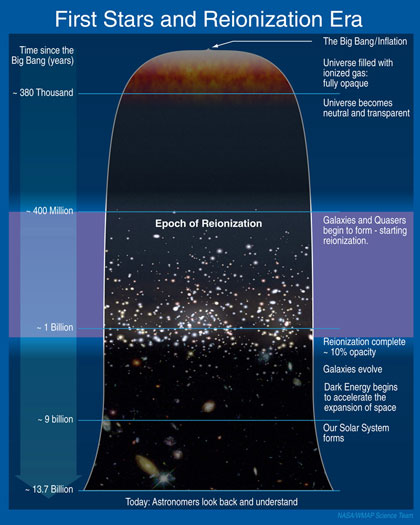
21 cm background
Image: The 21 cm background originates in the early so-called Dark Ages and the Epoch of Reionization, when neutral hydrogen emitted radiation due to spin-flip transitions. By mapping this radiation, cosmologists hope to learn much new information about the early Universe.
When the Universe became transparent - the onset of recombination - when the cosmic microwave background was formed, the hot plasma of which the Universe was composed became electrically neutral. Matter at that point existed mostly as atoms or simple molecules of the lightest elements, formed during Big-Bang nucleosynthesis. Otherwise, there was only radiation (which we now see as the CMB) and a few highly energetic remnants (some of which we now see in cosmic rays). Observations
indicate that dark energy was at the one per cent level of the total energy density during this time.) Another way of phrasing this is to say that the ionization fraction was very low. Or more simply still: most of the material Universe consisted of neutral hydrogen and a little helium.
In learning about the Universe during this epoch, one is faced with a challenge since this unionized material does not really emit light. However, thanks to a quantum-mechanical transition between hyperfine energy levels in hydrogen (called spin-flip transition), microwave radio radiation with a wavelength of approximately 21 cm is emitted. This allows observation of this epoch in the Universe, spanning the time from shortly after the Universe became transparent and neutral at an age of around 380 000 years, through the start of reionization of hydrogen in stars at around 400 million years, up to full reionization at an age of around 1 billion years. Once the radiation reaches Earth, the 21 cm line will be observed at frequencies from about 200 MHz to 10 MHz.
The 21 cm line from the local hydrogen abundance was first observed by Ewen and Purcell in 1951, and thereby kick-started the field of radio astronomy.
There are two main applications for cosmology. From the first, mapping of the redshifted 21 cm radiation, one can infer the statistical distribution of matter over time, which directly gives information about among other things dark energy, dark matter, neutrino masses, and inflation. It can be thought of as the cosmic microwave background measured at many different points in time. The second approach explores the “holes” in the 21 cm radiation due to neutral hydrogen which becomes re-ionized, mainly by the radiation from the first stars gradually switching on during this epoch. The hope is here to infer the details of the re-ionization processes and history.
This method of observation is still in its infancy, with a few first telescopes in operation. Many other projects are in the planning stages, notably the Square Kilometer Array. A first detection placing both upper and lower limits on the 21 cm background was announced in April 2013 by a team working with data from the Green Bank Telescope in the USA.
Links
Wikipedia: the 21 cm hydrogen line >
Multimedia
Jonathan Pritchard, Exploring the dawn of structure with the 21 cm line >

